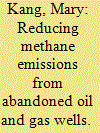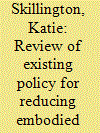|
|
|
Sort Order |
|
|
|
Items / Page
|
|
|
|
|
|
|
| Srl | Item |
| 1 |
ID:
168305


|
|
|
|
|
| Summary/Abstract |
This paper examines transitioning to low carbon vehicles such as battery electric vehicles (BEVs), hydrogen fuel cell vehicles (FCVs), and natural gas vehicles (NGVs) for curbing greenhouse gas (GHG) emissions in Japan. Infrastructure development for fuel charging stations for BEVs, FCVs and NGVs and the carbon tax are evaluated as policy measures to promote these vehicle fleets as well as the reduction in the life cycle GHG emissions. Our analysis uses the newly developed Japanese multi-regional partial equilibrium system dynamics model UniSyD_JP. The energy supply sector consists of fossil fuels, nuclear energy, renewable energy and hydrogen and the nation's energy demand is projected by the expected population growth and the GDP outlook. The energy demand for the transport sector is endogenously determined by a consumer's vehicle choice characterized by the multinomial logit model. We examine five scenarios for different mixes of infrastructure development, carbon tax and projected oil price. The transition paths to a low carbon vehicle fleet are explored for the period of 2016–2060. We found that infrastructure development increases the penetration of FCVs and NGVs, but it will not reduce the life cycle GHG emissions. Significant emissions reduction requires both infrastructure development and high carbon taxes.
|
|
|
|
|
|
|
|
|
|
|
|
|
|
|
|
| 2 |
ID:
166999


|
|
|
|
|
| Summary/Abstract |
Well plugging, the main strategy for reducing methane emissions from millions of unplugged abandoned oil and gas (AOG) wells in the U.S. and abroad, is expensive and many wells remain unplugged. In addition, plugging does not necessarily reduce methane emissions and some categories of plugged wells are high emitters. We analyze strategies and costs of five options for reducing methane emissions from high-emitting AOG wells - those which are unplugged and plugged/vented gas wells. The five options are: plugging without gas venting, plugging with gas venting and flaring, plugging with gas venting and usage, gas flaring only, and gas capture/usage only. Average plugging costs ($37,000 per well) can be justified by the social cost of methane, which considers air quality, climate, and human/ecosystem impacts. Savings as measured by natural gas prices and alternative energy credits can offset low plugging costs (<$15,400 per well) but are not large enough to offset average plugging costs. Nonetheless, reducing methane emissions from AOG wells is a cost-effective strategy for addressing climate change that has comparable costs to some current greenhouse gas mitigation options and can produce co-benefits such as groundwater protection. Therefore, we recommend including the mitigation of AOG wells in climate and energy policies in the U.S., Canada, and other oil-and-gas-producing regions.
|
|
|
|
|
|
|
|
|
|
|
|
|
|
|
|
| 3 |
ID:
186471


|
|
|
|
|
| Summary/Abstract |
The building sector is a significant contributor to global energy demand and greenhouse gas emissions and thus has a major role in combating climate change. To date, efforts to address this issue have focussed on reducing energy demand during building operation, resulting in significant reductions in this area. However, recent studies have shown that substantial improvements to operational energy efficiency have increased the relative significance of indirect or embodied energy demands and associated greenhouse gas emissions. Subsequently, policies addressing this next frontier of energy and emissions reductions are emerging. To understand different approaches and inform future development, this study reviews existing policy mechanisms targeting embodied energy and greenhouse gas emissions in the building sector for four countries – Australia, Canada, USA and United Kingdom. The study found that voluntary instruments dominate the policy landscape, with regulatory measures largely absent at national levels and confined to inconsistent application across lower levels of governance. Signals of change emerging from the analysis include growing private sector investment and increasing quantitative targets for reduction. The study concludes with the challenges facing this sector of energy governance, alongside recommendations for regulated caps, mandatory LCA reporting, prerequisite requirements in voluntary instruments, data accessibility and resolving methodological inconsistencies.
|
|
|
|
|
|
|
|
|
|
|
|
|
|
|
|
|
|
|
|
|